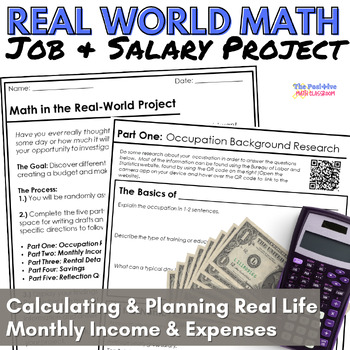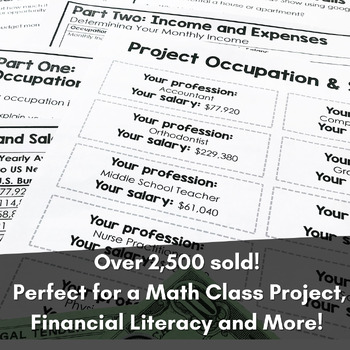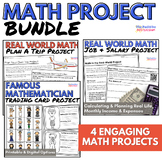Real World Math Project | Jobs, Salaries & Budgets
- Zip
- Google Apps™

What educators are saying
Also included in
- These ready to use projects are sure to be a hit with your middle school students as they learn more about using math in the real world. Not only can these be used anytime during the school year, but they are especially great to use as an end of the semester or end of the year math project. You wilPrice $14.35Original Price $20.50Save $6.15
Description
Whether you use the printable or digital version, this math in the real world project is ready to use and one that your students are sure to love. Not only are your students practicing important skills that include calculating percentages and budgeting, but they are also gaining knowledge of what the real world is all about. Perfect for the end of the year or anytime!
Included with this project and activity resource are the following:
- Digital version of the project made for Google Slides
- A printable pdf version of the project and activities
- Teacher Guide: Information about each of the activities and five parts of this project and ideas on how to implement them in your classroom.
- Introduction Activities (available as printables on the pdf)
- Vocabulary Chart: Students will work on defining basic terms needed to complete the project.
- Crossword Puzzle: Students will solve the puzzle based on vocabulary words and definitions in the chart.
- Salary and Occupation Matching Game: Students will work in groups or individually to match different occupations with salary amounts. This is a great way to get students thinking about occupations and what is considered a fair salary. They might be surprised by what they discover!
- Math in the Real World Project: Students will research a given occupation and calculate the cost of living. They will do this by completing each of five sections of the project. Each section gives detailed directions for students and includes:
- Part One: Occupation Research
- Part Two: Income and Expenses-Students will complete their monthly income and expenses calculations as well as decide on optional expenses.
- Part Three: Rental Research-Students will research an apartment they can rent according to their budget.
- Part Four: Savings-Students will list items they would like to save for and calculate how long it will take to save for these items.
- Part Five: Reflection Questions
- Grading Sheet: A simple grading sheet is also included for both students and teachers to complete.
- An EDITABLE PowerPoint file is included for teachers to edit the occupation list and/or the grading sheet.
Here is what other teachers are saying about this project:
"Loved this! Did this an as end of the year project and my students loved it."
"Great independent project. Kiddos enjoyed the research."
"This resource is ready to print, and great to use to introduce the topic of budgeting."
"I wish we had more time to spend on this because there are many practical and real-life connections that can be made. Great introduction to some good topics."
"Not only did my kids practice math, but they learned a great lesson of responsibility when they get older!"
Looking for more real world math? You may also be interested in the following:
The Math Behind Holiday Shopping
The Math Behind New Year's Eve
The Math Behind Time's Square NYE
Click here to follow me for updates on new products that are always 50% off for the first 24 hours!






